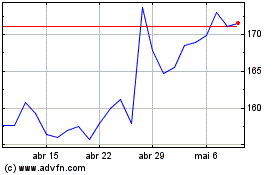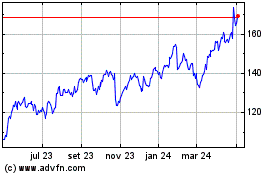Japan Advances on Self-Driving Road
01 Outubro 2015 - 10:00AM
Dow Jones News
TOKYO—Toyota Motor Corp. on Thursday started selling a safety
device that allows a car to communicate with other vehicles or
traffic lights, part of an effort to change the perception that
Japan trails Silicon Valley in driving technology.
Separately, Tokyo-based Robot Taxi Inc. said it would work with
authorities to start an experimental driverless taxi service next
year, following in the footsteps of Google Inc., which has been
testing its self-driving cars on U.S. roads.
As Silicon Valley players such as Google champion self-driving
vehicles, many Japanese automotive executives have expressed
caution, saying more time is needed to make fully autonomous cars
feasible, and consumers may not want them.
That has led to a perception that Japan may have fallen behind
Silicon Valley—though Toyota, which has been studying autonomous
driving for two decades, says its technology is a match for
Google's.
Toyota's new device, which costs around $250 and is available
only in Japan, allows cars to exchange data with other cars or
infrastructure like traffic lights via radio waves.
For the moment, the device's usefulness is limited because it
can talk only to other versions of itself, and few traffic lights
or cars are equipped. But the company said it hopes eventually to
introduce the device in mass-market cars world-wide.
It could alert a driver about the location of other
vehicles—useful when visibility is poor—or tell how much longer it
will be before a red light turns green.
Toyota, like other auto makers, already includes in many new
models a crash-prevention system that consists of radar and a
camera. The new system is the next step by allowing cars to get
information from each other, rather than relying solely on radar
and camera images, said Toyota safety executive Moritaka
Yoshida.
"We believe that initially, safety technologies that can operate
independently will spread aggressively," Mr. Yoshida said. "That's
going to be followed by the ITS technologies"—intelligent transport
systems.
Different countries use different radio frequencies for
transportation purposes. But it is relatively easy for the device
to adapt, Mr. Yoshida said, observing that mobile phones can easily
be used in multiple countries.
Meanwhile, Robot Taxi Inc., a joint venture between
mobile-Internet company DeNA Co. and vehicle-technology developer
ZMP Inc., said it would offer driverless transport to about 50
people in an area near Tokyo, part of an experiment backed by Prime
Minister Shinzo Abe's government. Robot Taxi aims to commercialize
the service by 2020.
For now, the car, which will drive itself a distance of about
three kilometers (2 miles) between homes and grocery stores, will
carry crew members as an extra layer of safety.
Jun Hongo contributed to this article.
Write to Yoko Kubota at yoko.kubota@wsj.com
Access Investor Kit for "Toyota Motor Corp."
Visit
http://www.companyspotlight.com/partner?cp_code=P479&isin=JP3633400001
Access Investor Kit for "Toyota Motor Corp."
Visit
http://www.companyspotlight.com/partner?cp_code=P479&isin=US8923313071
Subscribe to WSJ: http://online.wsj.com?mod=djnwires
(END) Dow Jones Newswires
October 01, 2015 08:45 ET (12:45 GMT)
Copyright (c) 2015 Dow Jones & Company, Inc.
Alphabet (NASDAQ:GOOG)
Gráfico Histórico do Ativo
De Mar 2024 até Abr 2024

Alphabet (NASDAQ:GOOG)
Gráfico Histórico do Ativo
De Abr 2023 até Abr 2024
